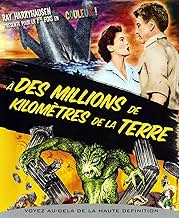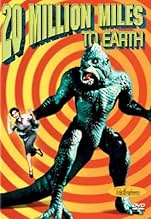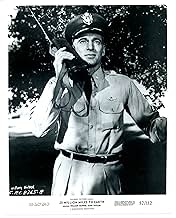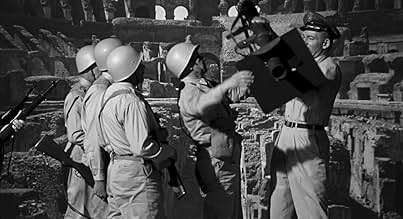VALUTAZIONE IMDb
6,3/10
8652
LA TUA VALUTAZIONE
La prima astronave Americana inviata su Venere atterra al largo della costa Siciliana, portando con se una mostruosa creatura simile ad una lucertola che diventa presto gigantesca.La prima astronave Americana inviata su Venere atterra al largo della costa Siciliana, portando con se una mostruosa creatura simile ad una lucertola che diventa presto gigantesca.La prima astronave Americana inviata su Venere atterra al largo della costa Siciliana, portando con se una mostruosa creatura simile ad una lucertola che diventa presto gigantesca.
- Regia
- Sceneggiatura
- Star
Thomas Browne Henry
- Maj. Gen. A.D. McIntosh
- (as Thomas B. Henry)
Bart Braverman
- Pepe
- (as Bart Bradley)
Sid Cassel
- Farmer
- (non citato nei titoli originali)
Neil Collins
- Technician
- (non citato nei titoli originali)
Paul Cristo
- Police Officer
- (non citato nei titoli originali)
Noel Drayton
- 1st Reuters News Correspondent
- (non citato nei titoli originali)
John Duke
- American Embassy Aide
- (non citato nei titoli originali)
Darlene Fields
- Miss Reynolds
- (non citato nei titoli originali)
Duke Fishman
- Fisherman
- (non citato nei titoli originali)
Michael Garth
- Minor Role
- (non citato nei titoli originali)
Ray Harryhausen
- Man Feeding Elephant
- (non citato nei titoli originali)
Recensioni in evidenza
The moment the film begins it draws the viewer into its story about a US mission to Venus that brings back a specimen of a creature that grows at an incredibly rapid rate in Earth's atmosphere. The creature is like nothing else ever before on screen with its lizard-like human head and human torso, and dinosaur like legs and tail. The story naturally concentrates on capturing this creature before it destroys Italy. Like other monster films where the monsters are the sympathetic ones and the real monsters are the people, 20 Million Miles to Earth depicts a creature that is inquiring, basically harmless unless provoked, and heroic despite its eventual fate. Ray Harryhausen did a terrific job with his stop-motion animation, especially when we see the beast battle an elephant in the streets of Rome. The acting is decent, not as bad as some critics would argue. The film is pure entertainment and yet another commentary on mankind and the whole concept of the stranger within our society.
I have to admit I was drawn to this because it was set in Sicily, but they really never got far from Rome.
It is a significant film for the fact that special effects were done by Ray Harryhausen, who has a cameo in the film (watch for the man feeding the elephant at the zoo.).
William Hopper, who played Perry Mason's assistant Paul Drake, will be a familiar face for those who grew up during the 50's and 60's. Joan Taylor was also on TV a lot during those years. They both have a rich sci-fi history in films like Earth vs. the Flying Saucers, "Men Into Space", and Conquest of Space.
The little Godzilla-like monster from Venus is the focus of the film as they try to find and capture it. Of course, Hooper knows all about the creature when facing it. Such plot holes would raise howls of derision today, but it was common in the films of the 50's.
An enjoyable reach into the past with a film that entertains more than a lot of the DTV we see today.
It is a significant film for the fact that special effects were done by Ray Harryhausen, who has a cameo in the film (watch for the man feeding the elephant at the zoo.).
William Hopper, who played Perry Mason's assistant Paul Drake, will be a familiar face for those who grew up during the 50's and 60's. Joan Taylor was also on TV a lot during those years. They both have a rich sci-fi history in films like Earth vs. the Flying Saucers, "Men Into Space", and Conquest of Space.
The little Godzilla-like monster from Venus is the focus of the film as they try to find and capture it. Of course, Hooper knows all about the creature when facing it. Such plot holes would raise howls of derision today, but it was common in the films of the 50's.
An enjoyable reach into the past with a film that entertains more than a lot of the DTV we see today.
This movie is a prime example of the work of one of the masters of stop-motion animation, a form of art that is rapidly being supplanted by CGI. Ray Harryhausen was the ultimate master of this technique, having trained under the likes of Willis O'Brian. His work is still the inspiration for many of the special effects wizards today. Granted, the movies of the 1950's do seem stilted and silly, but quite frankly, the worst of them are probably still superior to most of the direct-to-video drek produced today, and likely better than most of the films produced by major studios. I was raised on films such as 20 Million Miles to Earth and have no problem letting my child watch films like this. I cannot say the same for most of what is released today. 20 Million Miles to Earth is a unique, fun film. It, like others of its kind, comes from a different era, when people were not as jaded and world-savvy as they are today. Save the critical eye for the more cynical, overproduced films of today. Enjoy it for what it is.
Let's state the obvious right off the bat. If it weren't for the stop-motion animation in this film, it would be simply awful. Awful acting, awful script, mediocre direction, this film has it all.
But once the monster appears on screen, none of that matters. Ray Harryhausen's animation is, as always, simply spellbinding, giving the monster, paradoxically, both a heightened reality (as it really is a physical object photographed in "real life") and a dreamlike quality. It's easy to see how Harryhausen's work set the standards for monster special effects until Star Wars and computer animation came along many years later.
This film is a particularly good example of his work for a number of reasons. There's only one monster (unlike the Sinbad/Jason/Titans movies), so all his effort is spent on that one "character". The monster also starts out small and grows huge by the end of the movie, allowing us to see it in a variety of settings. And, the fact that it's a humanoid (rather than a dinosaur or big octopus) allows it to "act" in a much more expressive manner (not unlike the original Kong).
So while this movie may qualify as little more than "MST3K" fodder as a science fiction work (did I mention how truly awful the script is?), as a piece of animation, it's a pure classic, deserving a space on your shelf next to King Kong, Snow White and Fantasia.
But once the monster appears on screen, none of that matters. Ray Harryhausen's animation is, as always, simply spellbinding, giving the monster, paradoxically, both a heightened reality (as it really is a physical object photographed in "real life") and a dreamlike quality. It's easy to see how Harryhausen's work set the standards for monster special effects until Star Wars and computer animation came along many years later.
This film is a particularly good example of his work for a number of reasons. There's only one monster (unlike the Sinbad/Jason/Titans movies), so all his effort is spent on that one "character". The monster also starts out small and grows huge by the end of the movie, allowing us to see it in a variety of settings. And, the fact that it's a humanoid (rather than a dinosaur or big octopus) allows it to "act" in a much more expressive manner (not unlike the original Kong).
So while this movie may qualify as little more than "MST3K" fodder as a science fiction work (did I mention how truly awful the script is?), as a piece of animation, it's a pure classic, deserving a space on your shelf next to King Kong, Snow White and Fantasia.
I think the best thing about this movie is that it's fast-moving. The filmmakers don't waste a lot of time with unnecessary dialog or a sappy romance. They get right to it and stay on track for almost all of the 82 minutes.
Thus, if you like somewhat-hokey 1950s science-fiction movies dealing with space or monsters, or in this case both of them, you should enjoy this little film. Most of it involves trying to cope with a specimen from Venus which quickly grows into a Godzilla-like monster (but smaller).
It seems a space ship had gone to Venus, but crashed on the way home. Only good-guy William Hopper, who used to help Perry Mason win courtroom cases on TV about this same time, survives the crash. The ship lands in a big body of water off Italy. The specimen, about the size of a trout, washes onshore where a little boy finds it and then shows it to his scientist-uncle. Within hours, it seems, the "thing" begins to break out of its ice encasing and - presto! - we have a small little Godzilla. Hours later, it's about the size of a small man. Very soon it's several times the size of a man.
Here's the good and bad news on the special-effects, which are crucial to a film like this. With Hall of Fame FX man Ray Harryhausen, you know you're going to get the best of what you can expect from a film 50 years ago. Compared to most films of its ilk during the '50s, this is good stuff and the creature looks and moves in a pretty realistic manner. The only "goof" is that in some scenes, such as the one in the barn, the monster looks about three feet high in some shots, and 20 feet in others. The scale gets thrown out of whack a few times and then several times later in the film. Thus, you never really know how big this lizard-creature is. Overall, however, it's still done extremely well for its time period.
There is a scene, too, where the alien creature fights an elephant! Once again, for something 50 years old, they did an excellent job re-creating what that fight might look like. It was well done....and how often do you see a monster fighting an elephant?? Pretty cool stuff. By the way, I watched the colorized version and the monster was green.
The acting is passable, too. Hopper, as "Col. Robert Calder," knows what's he doing, as do most others in here. Some of the actors are familiar faces from '50s and '60s television. The female interest - which is played down - has Joan Taylor as "Marisa Leonardo." She's a bit bland but not bad-looking. She reminded me of Phyllis Coates, from the first season of "The Adventures Of Superman."
All in all, if you're looking for a campy and fun, along with fast-moving classic-era sci-fi flick, this is highly recommended. You won't be bored.
Thus, if you like somewhat-hokey 1950s science-fiction movies dealing with space or monsters, or in this case both of them, you should enjoy this little film. Most of it involves trying to cope with a specimen from Venus which quickly grows into a Godzilla-like monster (but smaller).
It seems a space ship had gone to Venus, but crashed on the way home. Only good-guy William Hopper, who used to help Perry Mason win courtroom cases on TV about this same time, survives the crash. The ship lands in a big body of water off Italy. The specimen, about the size of a trout, washes onshore where a little boy finds it and then shows it to his scientist-uncle. Within hours, it seems, the "thing" begins to break out of its ice encasing and - presto! - we have a small little Godzilla. Hours later, it's about the size of a small man. Very soon it's several times the size of a man.
Here's the good and bad news on the special-effects, which are crucial to a film like this. With Hall of Fame FX man Ray Harryhausen, you know you're going to get the best of what you can expect from a film 50 years ago. Compared to most films of its ilk during the '50s, this is good stuff and the creature looks and moves in a pretty realistic manner. The only "goof" is that in some scenes, such as the one in the barn, the monster looks about three feet high in some shots, and 20 feet in others. The scale gets thrown out of whack a few times and then several times later in the film. Thus, you never really know how big this lizard-creature is. Overall, however, it's still done extremely well for its time period.
There is a scene, too, where the alien creature fights an elephant! Once again, for something 50 years old, they did an excellent job re-creating what that fight might look like. It was well done....and how often do you see a monster fighting an elephant?? Pretty cool stuff. By the way, I watched the colorized version and the monster was green.
The acting is passable, too. Hopper, as "Col. Robert Calder," knows what's he doing, as do most others in here. Some of the actors are familiar faces from '50s and '60s television. The female interest - which is played down - has Joan Taylor as "Marisa Leonardo." She's a bit bland but not bad-looking. She reminded me of Phyllis Coates, from the first season of "The Adventures Of Superman."
All in all, if you're looking for a campy and fun, along with fast-moving classic-era sci-fi flick, this is highly recommended. You won't be bored.
Lo sapevi?
- QuizThe film was originally going to be set in Chicago, with the rocket crashing in Lake Michigan. Right before submitting the idea to producer Charles H. Schneer, Ray Harryhausen decided to change the setting to Italy at the last minute, after deciding that he always wanted to go on vacation there.
- BlooperThe spaceship crashes into the water no more than 100 yards from the fishermen. Yet their boats are in no way affected by any disturbance of the water. A vessel that large crashing into the water would have created a large wake that would have at the least rocked the boats heavily, if not capsized them.
- Citazioni
Dr. Judson Uhl: You better tell them we're in a hurry and to roll up the red tape and put it into a drawer until this thing is over!
- Curiosità sui creditiOpening credits prologue: A FISHING VILLAGE IN SICILY
- Versioni alternativeMany local TV stations delete the scene in which the Ymir kills an elephant from a zoo, claiming the scene is a needless depiction of cruelty to animals.
- ConnessioniEdited from Ultimatum alla Terra (1951)
I più visti
Accedi per valutare e creare un elenco di titoli salvati per ottenere consigli personalizzati
- How long is 20 Million Miles to Earth?Powered by Alexa
Dettagli
- Data di uscita
- Paesi di origine
- Lingue
- Celebre anche come
- A 30 milioni di Chilometri dalla Terra
- Luoghi delle riprese
- Azienda produttrice
- Vedi altri crediti dell’azienda su IMDbPro
- Tempo di esecuzione1 ora 22 minuti
- Colore
- Proporzioni
- 1.85 : 1
Contribuisci a questa pagina
Suggerisci una modifica o aggiungi i contenuti mancanti























